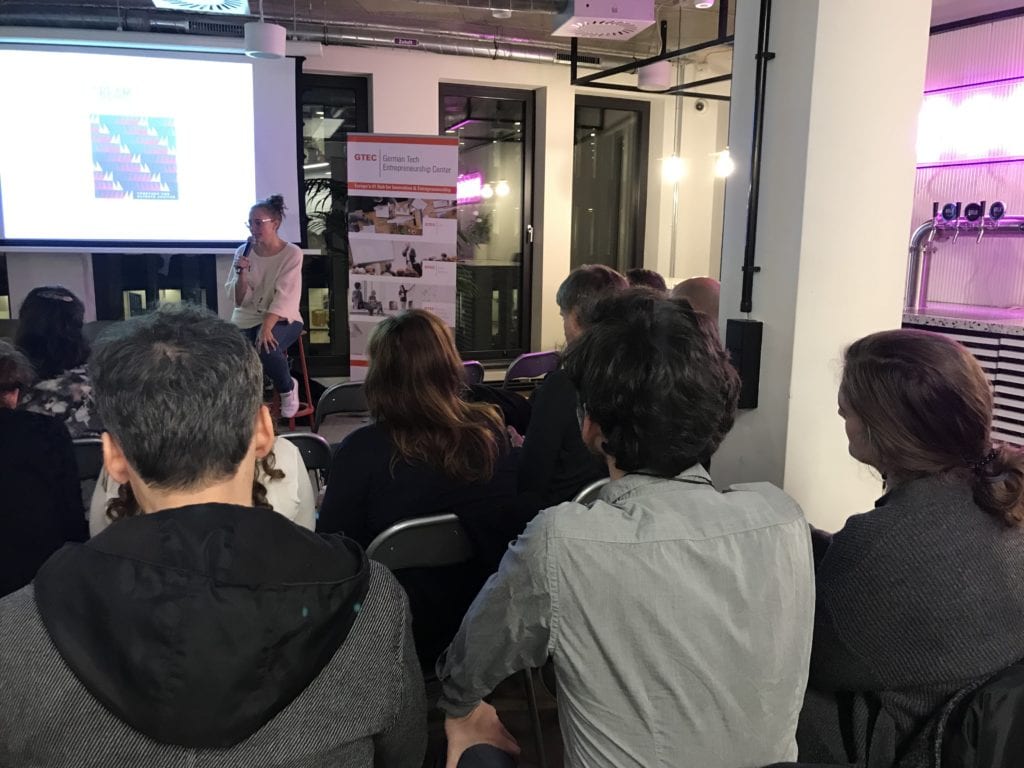|
Getting your Trinity Audio player ready...
|
We asked the Berlin publishing community for their best practices with regards to audience development and revenue streams.
On 27 February 2019, Bibblio hosted the fourth edition of the ‘Future of Media & Publishing’ event at the German Tech Entrepreneurship Center in Berlin.

The evening featured a presentation by Anne-Sophie Garrigou (Editor-in-Chief at The Beam Magazine) and a panel with contributors Jonny Tiernan (Publisher & Editor-in-Chief at LOLA Magazine), Robbie Wild Hudson (Editor-in-Chief at BOXROX) and Elena Poughia (Managing Director at Dataconomy Media). My colleague and co-founder of Bibblio, Mads Holmen, played the part of panel moderator.
Read on for the evening’s highlights and grab Anne-Sophie’s presentation slides as well.
Content syndication and diversification of revenue are moving the needle
Anne-Sophie shared the story of The Beam, a tri-annual printed publication covering the energy transition and the race to a zero carbon economy. The publication is available at 2 airports, 500 cafés, 15 satellite publishers, +1100 companies in 50 countries and they have subscribers from 26 countries. Their print magazine has been Anne-Sophie’s dream from the beginning, but they have a Medium blog too:
“To make our print publication work it was pretty clear to us we needed to be online. Twitter is my favourite social channel. It’s a great place to grow our online reach, and get a diverse audience too. The most article views on our blog come through Twitter.”

Other social platforms haven’t made a huge shift for them. As reports are coming out that, for the first time in a decade, Facebook usage is declining, Anne-Sophie shares her mixed feelings:
“Facebook? Well, it’s Facebook. We feel we should be present, but it’s not doing much for us with regards to driving traffic to our online content or merchandise.”
What is moving the needle for them is syndication efforts with other like-minded publishers:
“We share our blog content on the sites of CleanTechnica and FAIRPLANET. This partnership allows us to reach a broader audience and has driven lots of subscriptions to the print edition as well.”
Late last year, Media Voices’ Media Moments report mentioned the importance of diversification of revenue for publishing businesses. This will be key for the growth of The Beam this year, according to Anne-Sophie:
“To individuals, we offer print subscription. To not-for-profits, we offer distribution partnerships. To companies, we offer sponsored content. This is limited and we retain control on editorial and design. That’s important as we believe sponsored content needs to look completely different to opinion or editorial content. To conferences, we offer a free page of advertising in print and social media advertising – in return, they have to pay for our travels and appearance, and become a distribution partner as well.”
Want to dive into the numbers behind The Beam?
Download Sophie’s presentation
How are publishers growing their audience?
Next up at our event was the panel, which covered two big questions: how do I acquire my audience and how can I actually make a living from them?

Regarding the first part, all panel guests declared that organic traffic through Google is their most important acquisition channel. Robbie at BOXROX describes it as being at the centre of what they do:
“We have an SEO policy in place and we continuously work on that. To have a great number of articles on the basis of that is our golden nugget.”
And it seems to work well, as this month (February 2019) is the first time BOXROX will hit a million unique readers. Accepting articles written by the community (i.e. experts or enthusiasts) is another way to drive a broader, diverse audience and to get the most out of a smaller editorial team, Elena adds.
BOXROX also works with a browser push notification that currently allows them to reach 30,000 people, which they use for important news articles. Google’s AMP has been great at driving more traffic too.
Offline has a great impact as well, also for digital publishing, Elena mentions:
“We do a lot of community activities and these offline events are the way many people find out about us.”
LOLA Magazine, which has an online offering, is focused primarily on offline. Jonny mentions they distribute 5,000 copies of each issue throughout Berlin’s cafés, art galleries, cinemas and bars:
“LOLA’s web traffic is mostly referred from Facebook, which works because of our locality. We utilise digital for telling more of the stories that won’t fit in our print magazine that only has 48 pages and gets published every four months.”
How can you make a living as a publisher?
Nowadays, digital publishers are finding other ways to make money beyond (programmatic) advertising on their site. Benefiting from your loyal audience through your newsletter is a no-brainer for Elena:
“Our strength is the community we’ve built. The thing we monetize the most is our newsletter. It works well that we can show our advertisers a specific audience being interested in a specific topic. We offer them a paid email blast or just a banner.”
BOXROX relies on sponsorship income, directly signed with a partner. Robbie explains how it works, with packages starting at €1,500:
“That would get you space on a leaderboard banner or one on the side. We also have a pop-up on our site; we have experimented with that to make it as ‘not annoying’ as possible. Partners can pay for impressions or for clicks, which is more expensive.”
Sponsored content is the most premium way for working with BOXROX. The top end of these editorials, €2,500 are way up, and are mostly reviews of products or editors, or Robbie himself following a training program and writing about it.
Lastly, the majority of the revenue for LOLA Magazine comes from work for brands, dubbed as “agency work” by Jonny:
“We use our magazine as an advertisement for the work we do in the background; using our writers, photographers and editors to produce articles and media for other people. We could publish this work through their site and ours.”
Berlin publishers’ outstanding quotes
As an encore to our contributors to the panel, let’s finish with some strong quotes:
“Speaking from experience, you can pretty much do everything to make a niche publication work with 5 full-timers: at the publication I worked before we had five people doing a hundred-page magazine every month.” – Jonny
“Have a strategy for everything you do. Really be consistent, invest time and be patient. We did a couple of surveys, and our audience really wants to read long-form articles, not news. So we now focus on publishing pieces with more than a thousand words.” – Elena
“If you’re beginning and want to grow your publishing business, then focus on working together with people who could offer you content of such high quality you can’t find it anywhere else.” – Robbie
by Robbert van der Pluijm
Republished with kind permission of Bibblio, a company that helps publishers increase audience and revenue without invasive and irrelevant adtech.


